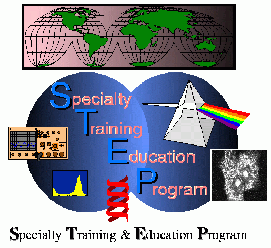 |
 |
 |
 |
 |

[Introduction to STEP]
[Table of Contents]
[STEP HomePage]
[Search for Keyword]
Cytometry Laboratory Howard M. Shapiro, MD., P.C. 238 Broadway Cambridge, Massachusetts 02139-1926
1. Facilities: Approximately 1400 square feet of laboratory space are available at our Cambridge facility; this houses our flow cytometers, facilities for cell culture and reagent and sample preparation and microscopy, and a small shop for mechanical and electronics fabrication. There are also approximately 600 square feet of office space.
2. Instrumentation:
Flow cytometers: The "Main Mutt" flow cytometer has air-cooled helium-cadmium and argon laser sources to which an additional helium-neon source can be added; as many as eight detectors can be used. A second instrument is equipped with a high-power, dual wavelength UV/blue helium-cadmium laser for measurements of chromosomes and bacteria. There are also small cytometers using argon ion and helium-neon or diode laser sources. Each cytometer is equipped with a dedicated computer system. An Ortho Cytoron Absolute cytometer is also now in the laboratory. Components for flow cytometer construction ad hoc abound.
Microscopy: Nikon phase/fluorescence, brightfield/darkfield, and stereo microscopes.
Spectroscopy: Hitachi spectrofluorometer and UV-VIS spectrophotometer, both computer-controlled.
Computers and analytical: Instruments are interfaced to 386 and 486-based, PC-compatible systems running 4Cyte software under DOS and Windows, with output to color inkjet and/or laser printers. Macintosh computer systems are also available, as is shareware for FCM data analysis running under Windows. Microsoft Word, Excel, and Powerpoint are available on both platforms, as is Canvas; in addition, we have Micrografx Draw and Corel Draw for Windows and Adobe PhotoShop and DeltaGraph for the Macintosh. A scanner and slide recorder are interfaced to a Macintosh. Aries Knowledge Finder and the MEDLINE database on CD-ROM, Niles EndNote Plus and EndLink are available on both platforms, and we have Internet access via 14,400 band modem. We also have Borland and Microsoft C++ compilers and Forth software development systems for DOS, Windows, and the Macintosh.
Other: Facilities for growing cells and bacteria.
3. Specialization Areas: We have been involved in the development of multistation, multiparameter flow cytometry and related cytochemical and analytical methodology, predominantly as applied to analysis of cell activation and to characterization of blood cells and bacteria. We also have assisted a number of organizations and individuals in construction of flow cytometers, and supply hardware and software for this purpose. We are currently focusing on the refinement of high-resolution linear electronics for use in quantitative fluorescence analyses.
4. Special Opportunities: Flow cytometric analysis of intrinsic and extrinsic parameters in cultured cells and bacteria, construction of special-purpose and/or low-budget flow cytometers; software development using the extensible Forth language.
5. Special Courses Offered: None at this time.
6. Graduate Program: None at this time.
7. Local Accommodations: The Cambridge/Boston area has many excellent hotels, most of which are too expensive. The nearest to us is the Marriott at Cambridge Center. By way of compensation, a lot of good food at reasonable prices is available nearby.
8. Transportation: The laboratory is about 20 minutes by cab from Logan International Airport; a rapid transit station which provides connections to the airport and to South Station (Amtrak) is a 10 minute walk away. Immunization against bad puns is recommended.
9. Cost of Internship: Negotiable.
10. Communication:
Howard M. Shapiro, M.D. Cytometry Laboratory Howard M. Shapiro, M.D., P.C. 238 Broadway Cambridge, Massachusetts 02139-1926 Phone: (617) 576-0660 FAX: (617) 576-0662 E-mail: hpanda@harvarda.harvard.edu
 |
 |
 |
 |
 |
CD-ROM Vol 3 was produced by Monica M. Shively and other staff at the Purdue University Cytometry Laboratories and distributed free of charge as an educational service to the cytometry community. If you have any comments please direct them to Dr. J. Paul Robinson, Professor & Director, PUCL, Purdue University, West Lafayette, IN 47907. Phone:(765) 494-0757; FAX (765) 494-0517; Web http://www.cyto.purdue.edu, EMAIL cdrom3@flowcyt.cyto.purdue.edu